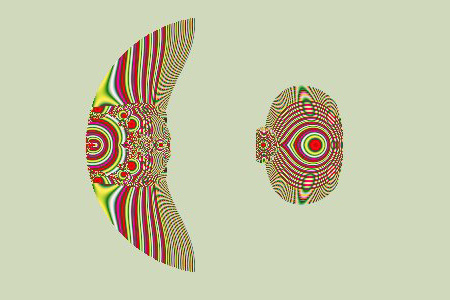
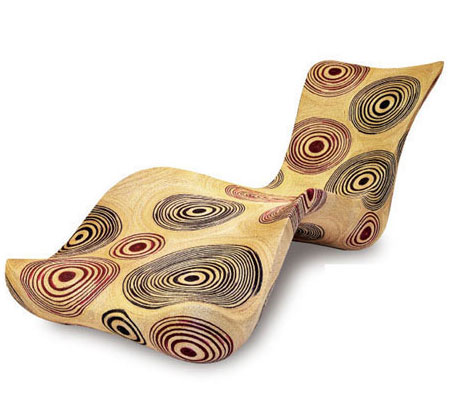
The 2-D fractal images came from Tim Hodkinson's blog. The 3-D image came from somewhere on the wide Internet (sorry).


The 2-D fractal images came from Tim Hodkinson's blog. The 3-D image came from somewhere on the wide Internet (sorry).
When I started making drawings on an office computer with Microsoft Paintbrush (mid '90s), and music on a Mac SE with Music Works software (late '80s), they weren't retro. My hope at that time was to demystify "computer art" by using everyday programs that people might have come into contact with. The key word wasn't outmoded, it was "simple." I was dismayed by the bad programmer art I was seeing, which was starting to appear in museums. I thought the best way for a fine art trained artist to use a PC was in the most straightforward, transparent way. For example, to make a hand painted portrait that was clearly done with a paint program and no accompanying narrative about the means of production. This turned out to be harder than I thought -- viewers assume anything made on a PC uses algorithms or software "cheats." Hand skill is effectively overwhelmed by the medium.
By the mid-2000s, I was stubbornly clinging to MSPaint and 8-Bit music as they became retro styles. In 2004 I began experimenting with animated GIFs, applying some of the pixelly MS Paint ideas I had been working with. At that time GIFs were definitely retro and seen as a '90s, dot com era phenomenon. I thought about Richard Phillips' use of dated fashion photography to make large scale oil paintings and remembered this 1987 quote from Dan Graham:
According to [Walter] Benjamin, "progress," the 19th-century scientific and ultimately capitalist myth, is expressed in commodities, fashion goods which "produce a sense of eternal newness." This makes progress a mythical goal, never to be reached, for there is always the new and it is always superseded by the next new. For Benjamin, then, progress is actually a state of stasis. And yet it is the very stasis that makes the recovery of the just-past potentially subversive.
I believe now that the task of the artist is in part to resuscitate the just-past -- that period in time made amnesiac by commodity culture -- and to apply it as an "anti-aphrodisiac" (Benjamin's phrase). The Rolling Stones song "Yesterday's Papers" -- "Who wants yesterday's papers? Who wants yesterday's girl? No one in the world" -- makes this anti-aphrodisiac aspect of the just-past clear. [1]
I never articulated my "program" the way artist and musician Pierre-Luc Verville does below but I think he gives a compelling reason for all those MS Paint drawings and animated GIFs:
What is contradictory in the computer aesthetic is between what we expect from computer tools and what they do. Moody exploits this paradox by turning the fundamental elements of the perceptual system of computer environments into expressive elements that refer directly to the history of art. By exaggerating what the computer may or may not be expected to produce aesthetically, Moody reveals a world whose conditions of aesthetic possibility are constantly being transformed by the machine.
The appropriation of obsolete devices is thus the occasion for a critique of the obsolescence of the various aesthetic stages of the computer, for a re-reading of the horizon of expectation which frames the experience of it. [2]
Just as the "simple" had been used to critique the overly complex, the "old" can be used to critique the seamless world of the so-called 4th Industrial Revolution: the interconnected virtual reality of smartphones and platforms -- the latest incarnation of Benjamin's stasis of eternal newness. A pixelated sphere was the best a drawing program could do in 1984. What limitations (or assumptions) might a super-duper slick iPad be putting on something made right now? I also appreciate Verville's implication that art history can be used as a gauge or measuring device. Unlike my attempts at portraiture, everyone can see that the pattern of concentric circles (Kenneth Noland target) is made up of pixels in my OptiDisc gif. What similar soon-to-be-dated constituent part might the seductive iPhone be hiding? In future posts, I'll be comparing my theorist of choice, Dan Graham, with Verville's, Marc Augé, on the topic of past-as-critique. (They are saying very similar things.)
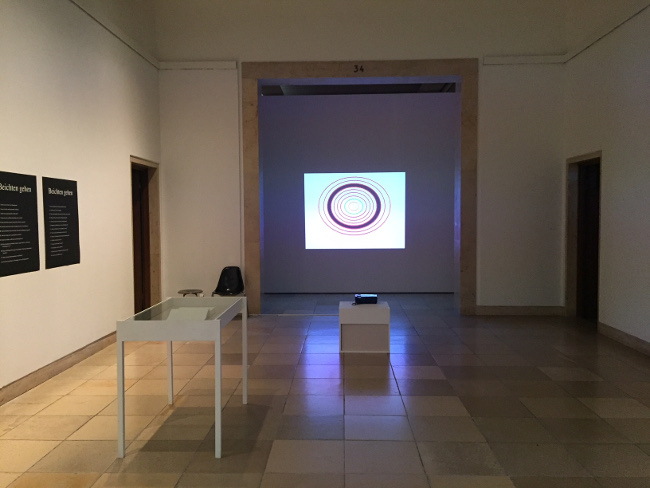
Tom Moody, OptiDisc, projection of animated GIF file, "PAUSE (Prelude)" exhibit, Haus der Kunst, Munich, Germany, 2018
NOTES
1. Dan Graham, "Legacies of Critical Practice in the 1980s," Discussions in Contemporary Culture, Hal Foster, ed., Dia Art Foundation, 1987
2. https://leparergon.org/index.php?title=Tom_Moody (French) https://www.tommoody.us/archives/2021/06/08/le-parergon-tom-moody-bio/ (English)
I created a Vimeo "showcase" here of some interviews, performances and panel appearances from 1988 to the present. Here's an embedded playlist of the same items:
And below are my notes on the vids; the links go directly to the individual videos, bypassing the showcase. You may see banner ads on individual video pages, sorry. (I only recently learned Vimeo is doing this.) If you stay in the "showcase" or playlist, you shouldn't see ads.
1. Comment reading at Rhizome.org Telethon (2014)
I was pleased to be invited to read aloud from a selection of my comments to Rhizome blog posts, as a kind of stunt to raise money for the organization. My enjoyment waned when I found out later the microphone was so poor no one could understand me. To salvage this waste I added captions.
The comment I am reading is a semi-ironic response to a post by Rhizomer Ceci Moss, who used the term "hermetic" as if it were something vaguely distasteful. After all, we are all networked now and Rhizome supports "networked art."
I sang the praises of the "hermeticist artist," including two Moss had chosen as examples of non-hermetic practitioners.
The video was streamed from Lu Magnus Gallery, New York, NY.
2. Tom Moody interview (2017)
Two rough-cut edits of interview for documentary on "glitch art" by Travis Basso.
The two cuts are mostly identical: The first version discusses the "OptiDisc" .gif and has a has a shorter explanation of the printing-error artworks on paper.
The second version has more explanation of the printing-error artworks and omits discussion of "OptiDisc."
Video, sound, editing: Travis Basso
3. "Control Panel" (2015) exhibition, Brooklyn, NY
Panel discussion on July 25, 2015, in connection with "Control Panel" group show at Honey Ramka gallery.
Panelists (l to r): Tom Moody, James Clark, Linda Francis, Ben Garthus, Micah Ganske
Moderator: Veronika Szkudlarek
This an excerpt from the discussion; the full version can be found on YouTube - part 1 / 2
Responding to the anti-tech drift of the conversation, one of the panelists suggests that people who criticize software or tech services don't know how to use them properly, or don't know the difference between good and bad "apps." He includes Twitter as an example of the human progress that technology has engendered, but says he doesn't use the platform himself and offers no examples of an evolved way to use it.
4. Performance (2012), Apex Art, New York, NY
Live performance of several musical works.
"As Real As It Gets" exhibition, curated by Rob Walker.
The sound art component of the show was organized by Mark Weidenbaum.
Musicians were asked to make music based on field recordings of commercial, retail businesses.
Two of my tracks were done this way, four were original tunes not related to the theme.
Video and audio recording: Apex Art, NY, NY
5. New Museum, NYC, Net Aesthetics 2.0 panel, June 6, 2008
Left to right: Kevin McCoy, Jennifer McCoy, Tim Whidden, Ed Halter (moderator), Tom Moody, Petra Cortright, Damon Zucconi
This is a "panelist's cut" of a longer discussion made available for public download by Rhizome.org, sponsor of the panel at the New Museum, New York, NY.
Captions were added for less audible portions of the discussion.
6. Lecture/Performance (2006), artMovingProjects, Brooklyn, NY
The video is divided into six parts, a lecture followed by five songs for drum machine and SIDStation: Godhopper, Clip City, Protest Song Variation, Suite 6, and artMoving
Video camera: Aron Namenwirth
Conversion of tape to digital: Justin Strawhand
7. KHOU-TV interview (1994), Houston, TX
Discussing The Big Show, an annual event that I was in the process of jurying, at Lawndale Art & Performance Center in Houston, Texas
Photos of the completed installation are here.
8. Art Breath (1990) - part 1 / 2 / 3 / 4 - Tom Moody studio visit
Originally aired on Cable Access of Dallas, Dallas, Texas
Tre Roberts visits me in my studio
Video co-produced by Tre Roberts & Lee Murray
9. Ask an Artist (1988) -- Tre Roberts interviews P.M. Summer and Tom Moody
Originally aired on Cable Access of Dallas, Dallas, Texas
Summer and I discuss our inclusion in "Memory," a show at UT Arlington's CRCA (Center for Research in Contemporary Art), commemorating the 25th anniversary of the Kennedy assassination; we also display other art we've made. Some discussion of my paintings was lost when I clumsily erased a section of the tape.
A version of my OptiDisc animated GIF will be in a show next week at Munich's Haus der Kunst. The show opens July 21, 2018 runs through July 29 (announcement below), and is presented by Künstlerverbund im Haus der Kunst. The co-curators are Courtenay Smith, Albert Coers, and Alexander Steig.
OptiDisc (Paused) [1 MB .GIF] adds a one-second pause after five loops of the GIF. This imitates the DVD version (video), which "hangs" at the reset point.
Many thanks to John Romero for his projector-friendly version, which spared me having to convert the GIF frames to .mp4 or some abomination like "webp" or "gifv." He embedded the GIF in an html container, allowing crisp, non-blurry resizing. Eventually I'll be doing a "7 on 7" with John, where I act as technologist and make all his concepts unworkable.
So for the "PAUSE (prelude)" show I'll have an ironically DVD-imitating GIF that hasn't been turned to mush in the conversion process. (The DVD version is usually shown on a CRT screen, which disguises some of the artifacts, but this way I don't have to ship one to Germany and fret about calling the CRT doctor.)
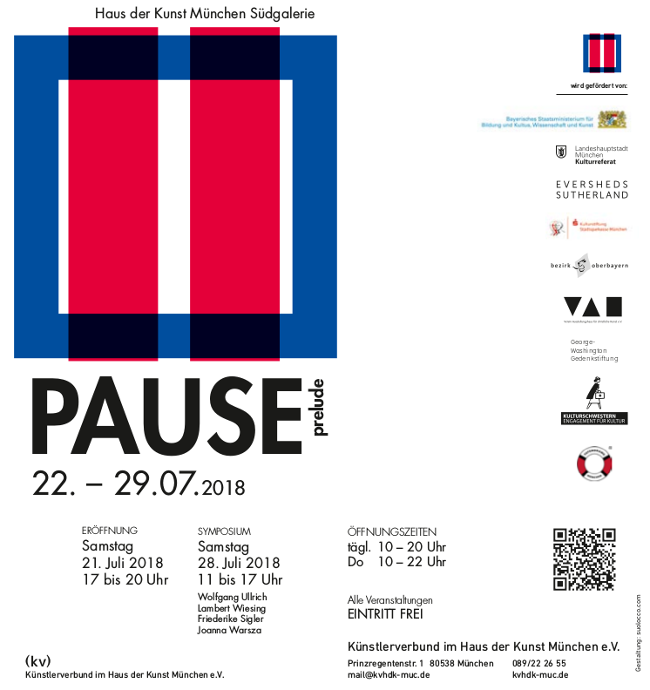
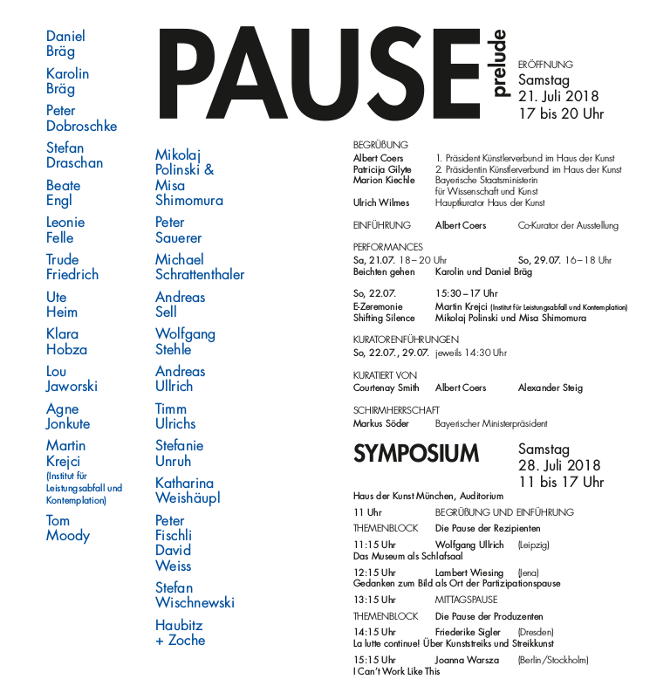
Art F City reports that e-flux and deviantart.com lost their joint bid for .art, the so-called generic top level domain created by ICANN, the internet naming cartel.
ICANN's plan to offer specialized "not-coms" has been criticized as unnecessary at best and a protection racket at worst.
It cost $185,000 just to apply for a domain. E-flux, an art-listing-with-theory service run by artist Anton Vidokle, promised to make administration of .art broad-minded and fair if it won, but Rhizome writer Orit Gat noted that “wield[ing] a kind of centralized power ... seems incongruous not only with the egalitarian politics advanced through e-flux’s editorial, but also with the concept of the Internet as a shared resource.” [link added -tm]
The winner of the domain, UK Creative Arts Limited, plans to use it for:
the creation of an online community for artists, owners and keepers of works of art, commercial art organisations (such as galleries and auction and trading houses), not-for-profit organisations (such as museums, foundations, professional associations), supporting businesses (such as insurance, appraisal, transport) and customers and members of the general public interested in art.
That sounds kind of familiar. Going back in time, here is how e-Flux described itself when it launched in the 1990s:
The e-flux mailing list is made free for readers by a set fee paid by museums and other institutions of art to publish their press releases and other communiqués via e-flux. All information disseminated is permanently archived for reference and research. While its network is limited to public art centers and museums, e-flux offers similar platforms to commercial galleries through its art-agenda subsidiary, and to art schools and art academies through art&education, which e-flux jointly administers together with Artforum International.
This is a business model, and 17 years later it's still a business (apparently doing well enough to scrape together $185,000). Despite having "flux" in the name, what's being offered is the stability of a permanent archive. Which is a kind of power. To support e-Flux in its bid for .art, you would have to assume that (i) it would have no editorial/curatorial/gatekeeping stance in running the domain, which is impossible unless every registration is granted, or (ii) that its criteria for granting domain rights agreed with your notion of good or acceptable art. e-Flux supports many worthwhile projects (including an OptiDisc) and they'll continue to be able to do so without the added authority of deciding who has "art" appended to their names. People might actually care to have this designation, since e-Flux has spent years building a rep as a place for theory, whereas ".art" as administered by something called UK Creative Arts Limited will be seen, at least initially, as another private commercial fiefdom (i.e., of little consequence to left intellectuals). Art F City attempts to demonize the winner as the puppet of a "Russian Venture Capitalist" -- possibly a venture communist would be more acceptable?
It will be interesting to see if any cognizable editorial position emerges out of UK Creative Arts Limited's newfound "centralized power." None of this should be of any great concern since we're being told that serious art discourse has moved to Facebook.